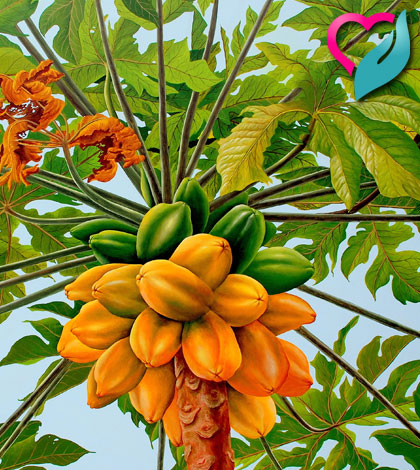Papaya is a small, unbranched tree, with a single stem growing to 5-10 m tall, with the spirally arranged leaves. The lower trunk is conspicuously scarred with the leaf.
[wp_ad_camp_1]
The leaves are large, 50-70 cm diameter and deeply palmate lobed, with seven lobes. The fruit of the plant is cultivated by tropical people, as a breakfast fruit. The plant is native to the tropics of the Americas. In Mexico, it was cultivated many centuries before the emergence of the Mesoamerican classic cultures. In India, papaya is cultivated throughout the country and is known for its medicinal properties.
[wp_ad_camp_4]
Plant Chemicals
The fruit calories, protein, carbohydrate, fiber, ash, Ca, P, Fe, Na, K, beta-carotene equivalent, thiamine, riboflavin, niacin, and ascorbic acid. The leaves calories, protein, fat, carbohydrate, fiber, ash, Ca, P, Fe, Na, K, beta-carotene equivalent, thiamine, riboflavin, niacin, and ascorbic acid, as well vitamin E. Leaves contain the glycoside, carposide, and the alkaloid, carpaine. Fresh leaf latex contains water, caoutchouc-like substances, pectinous matter and salts, malic acid, papain, fat, and resin. The seeds are reported to contain protein, fatty oil, carbohydrate, crude fiber, ash, volatile oil, a glycoside, caricin, and the enzyme, myrosin. The fatty oil of the seeds contains saturated acids (palmitic, stearic, and arachidic) and unsaturated acids (oleic and linoleic).
[wp_ad_camp_2]
Uses & Benefits of Papaya
- Papaya contains many biologically active compounds. Two important compounds are chymopapain and papain, which are supposed to aid in digestion. The level of the compounds varies in the fruit, latex, leaves and roots.
- It has been used for treating digestive problems and intestinal worms. The softening qualities of papain have been taken advantage of, in the treatment of warts, corns, sinuses, and chronic forms of scaly eczema, cutaneous tubercles, and other hardness of the skin, produced by irritation. Papain also is used to treat arthritis.
- The sinapisms prepared from the root of the plant are believed to be beneficial in treating the tumors of uterus.
- In the Asian countries, the latex of the plant is smeared at the mouth of the uterus, while the root infusion is used for syphilis in Africa.
- The latex is also used in curing psoriasis and ringworm in Cuba. It is also used as a local antiseptic in many parts of the world.
- The leaves of papaya tree are used for treating nervous pains and elephantoid growths. The infusion of its roots is said to reduce urine concretions.
- Dietary papaya reduces urine acidity in humans. The flowers from the plant are used in treating jaundice.
- Papaya latex, also used as dyspepsia cure, is applied to burns and scalds externally.
CAUTION
- Internally, papaya latex can cause severe gastritis. Some individuals are also allergic to its pollen, fruits and the latex.
- The acrid fresh latex can become the cause of severe conjunctivitis and vesication.
[wp_ad_camp_3]
Image courtesy : artsia.com , biobloomonline.com
























